
Serviceberries in April (photo by ALJ)
|

Serviceberries in fall color (photo by ALJ)
|

Native Serviceberries ripe (photo by ALJ)
|

Native Serviceberries ripe (photo by ALJ)
|
Serviceberry Trees (Amelanchier spp.)
|
| Suddenly, serviceberry bushes and trees are being used more prominently in Seattle-area landscaping. How about a review? What are they, what are their roles, and what special considerations apply? Since the plants are still relatively rare here, my comments are initial observations, not final judgements. Only time will tell how well the various kinds perform and in what conditions. You can help by being informed as to the basics, and by sharing with others those details you learn on the job. |
| Serviceberry or Sarvis and so on, is an eastern North American name referring to a group of related shrubs and trees, which, among other things, are distinguished by flowering when the shad-fish spawn. Shadbush, shadblow or shadberry are the precise names apropos this phenomenon. Julia Rogers wrote: "We may easily trace this common name to the early American colonists who frugally fished the streams when the shad were running, and noted the charming little trees lighting up the river banks with their delicate blossoms, when all the woods around them were still asleep." Other vernacular names include Juneberry (when the berries ripen), and a bookish European name, Snowy Mespilus, which harkens back to when Linnæus called some species Mespilus, whose profuse snowy white flowers shamed the sparse blossoms of the original Mespilus --the Medlar tree. |
| All these names apply to members of the genus Amelanchier, in the Rose Family, allied to hawthorns, crabapples, Photinia, etc. The name Amelanchier, surely, is of French origin, but is usually pronounced hard like "Amelankier." From 15 to 25 species comprise the genus, according to how finely we cut our distinctions. The trend among botanists is to allow fewer species but many hybrids. All are hardy and deciduous, except one in Mexico. All have little white or rarely pinkish flowers in early spring, followed by small seedy berries of varying colors and edibility. The fall color usually glows attractively. |
| Most are large shrubs or small trees, a few being either very low or notably large. For overall size, an Indiana specimen measured in 1974 may be the champ: 55 feet tall, 65 feet wide, its trunk 6 feet around! Both taller and stouter specimens are known, but no individual tree seems so large overall. Nobody ever plants one expecting it to grow so big! We assume the trees will be less than 35 feet tall. Out in the open, especially, they are shorter and broader. It is a good selection for planting on residential parking strips underneath overhead wires, or for use as a centerpiece tree in a tight little yard. |
Here is a list gleaned from books and nursery catalogs of the more treelike kinds, albeit some are usually just big shrubs. I tried to leave out those that are always shrubs, and there are many such.
|
| Amelanchier arborea |
| Amelanchier canadensis |
| Amelanchier canadensis Spring Glory® ('Springtyme') |
| Amelanchier canadensis Tradition® |
| Amelanchier x grandiflora (=A. arborea x A. lævis) |
| Amelanchier x grandiflora 'Autumn Brilliance' |
| Amelanchier x grandiflora 'Ballerina' |
| Amelanchier x grandiflora 'Cole's Select' |
| Amelanchier x grandiflora Cumulus® |
| Amelanchier x grandiflora 'Princess Diana' |
| Amelanchier x grandiflora 'Robin Hill (Pink)' |
| Amelanchier x grandiflora 'Strata' |
| Amelanchier lævis |
| Amelanchier lævis 'Prince Charles' |
Amelanchier x Lamarckii
|
| I don't really have a clue who's who among most of these names. Probably you can say "amen!" They are still too scarce and new. How can we sort the cultivars and decide which are best? No up-to-date book details the various kinds. Nursery catalogs differ, with some contradicting other accounts. I dearly want to know which kinds perform best here. But the only way we can determine this is by planting, recording, and comparing notes. |
| A general principle is worth any five itsy-bitsy rules if we're lost, or beginning. So let's start with sweeping statements, temporarily ignoring exceptions to the rules. |
| 1. The BLOOMS appear in late March and early April. They present dainty white flowers against a shimmering background of unfolding leaves. The flowers, small and numerous, are pretty always and at best superb. At the same time, our landscapes are exploding with flowers of grape hyacinth, forsythia, flowering plums, yoshino cherry, daffodils, periwinkle, red-flowering currant, forget-me-nots, aubretia, magnolias, tulips, and --admit it, cheerful yellow dandelions. |
| 2. The LEAVES are elegantly thin and narrowly elliptic, of small to medium size, medium green. Stressed plants bear smaller, yellowish leaves. On some varieties (A. arborea and A. canadensis) while unfolding in spring they are covered with shining silky hairs; other kinds (A. lævis, A. grandiflora and A. Lamarckii) have them emerging relatively hairless, with attractive rich bronze or purplish colors. Their red or orange fall color can be a stronger ornamental feature than the flowers --though in shade is only ho-hum yellow. |
| 3. The BERRIES turn to red, then purplish or bluish-black, but mostly are eaten by birds before achieving full softness. Their ornamental value is thus usually low. They are ok to eat, but nowhere near as delectable as blueberries, which they often greatly resemble. I eat them because they're healthy food, not because they taste delicious --but some kinds are much tastier, and any kinds might make excellent preserves. If harvesting fruit is important, it is advantageous to plant compact, low, bushy cultivars. Certain cultivars are far more fruitful than others, and are good choices for people interested in having fresh fruit in June and July. The bushy A. canadensis 'Prince William' is quite productive, as are various A. alnifolia cultivars. For superior fruit yields, plant different kinds together to get cross-pollination. It's interesting to note that many native Americans depended heavily upon serviceberries, gathering huge amounts, using them in pemmican-preparation and in other ways. |
| 4. The TRUNKS are slender, with tight gray bark, smooth like that of a holly or beech. If you set grass around such a trunk, be careful to not injure the bark when mowing. Only in great age does the bark get thicker and furrowed. Sometimes the young shoots and branches are warmly reddish-colored. |
| Nursery trees are usually grafted, trained to a single trunk, and throw up root-suckers as a response to genetic incompatibility, or because the rootstock is just naturally a suckering species --in which case it should not be used! In any case, cut off the rootsuckers during the growing season --thereby forcing the roots' surplus energy to be used by the trunk. That is the theory, at least, though sometimes it seems the main trunk stays weak and small-leaved, whilst the suckers are strong and lush. This may be beyond help, but try anyway: suppress the suckers, make sure the soil conditions are proper, and be prepared to wait several years. Finally, if the main trunk proves hopelessly unhealthy, scowl and saw it off as low as you can, then let the strongest sucker(s) grow up with your blessing to replace it. Do this in February or early March right before the buds burst. The result may be better, actually, because healthy understock is often preferable in the landscape to wretched-looking grafted cultivars. |
| Besides routine sucker removal, pruning may be done to encourage the desired shape and size. June is the optimal time. At this time the roots and foliage will be in approximate balance, thus suckering will be less likely, and some callusing of cuts can still take place. Probably a few narrow branch angles will need widening by spreaders, and weights can bend branches down in order to make the tree more graceful and floriferous/fruitful. If you like the broader, more horizontal look, the grandiflora selection named 'Strata' is worth trying. |
| Unlike cherries and apples, serviceberries are relatively free from pests and diseases. However, as we import more varieties and plant them widely, history assures us that we will encounter problems. We can count on it. Unfortunately, history doesn't specify which problems nor how to forestall them! (By 2016 in Seattle, both rust disease and powdery mildew blemish so many serviceberry trees here that I can no longer deem them worth planting.) |
| The plants are most vigorous in the deplorably rare condition of good soil: rich but moist and well-drained, and well-illuminated but not baked by sunshine. In an unirrigated site, or in soggy muck, or deep shade, trouble is likely. If a tough, low-maintenance choice is needed, our Northwest native species A. alnifolia (see below) is the only certain bet --others may also work but it is too early to be sure. I have seen some attempts to use Serviceberry trees in naturalistic, minimal-maintenance settings. Don't bother trying! The native, or others grown as shrubs, have a chance. |
| Our single native species, although bushy, deserves more attention, because we know it works admirably here without need of human tinkering. Moreover, it is quite different from the rest. A. alnifolia, or A. florida as some call it, has rather roundish, coarsely toothed leaves that color a plain yellow in fall. I refer to the race we have west of the Cascades. Its eastern cousins have longer, more pointed leaves, finely toothed, coloring brighter in autumn. Ours also flowers later, in late April and early May. Taken as a whole, the species is native in much of the West: it is the Saskatoon Berry. On the hot dry plains of Alberta and Saskatchewan, the berries of late June and July are a godsend treat to hungry hikers. Around Puget Sound, if birds don't nab them, they can be eaten into mid-August. |
| Several cultivars of A. alnifolia exist. The following notes were lifted from a book, still in manuscript form (The Garden of Joy, by James D. Searles, published in September 1990 in Great Falls, Montana by Medicine River Publishing), by Jim Searles: 'Altaglow' is tall, with great fall color, sparse white flowers; 'Honeywood' has big berries in big clusters; 'Pembina' has few rootsuckers; 'Regent' is a fruitful dwarf; 'Smoky' suckers much, is good for fruit; 'Thiessen' has big fruit, a long season, and is columnar. 'Northline' is still another cultivar, about which I can say nothing at present. Although old, seed-grown native serviceberries can be real trees, most are sprawling big shrubs. That is why I omit the species from the list of serviceberry trees. They tolerate dry soil, as well as shade. Actually, few shrubs are so undemanding. |
In conclusion, will you please plant serviceberries as an experiment? Doubtless some will work perfectly in our landscapes --but until we try we won't know. If you send me documentation of where you plant which cultivars, I shall be grateful --such information will be used to improve successive editions of Trees of Seattle, or shared in other useful ways.
|
(Originally written in July 1990 for the quarterly newsletter of the Association of Women in Landscaping, since changed to the Association of Women in Horticulture)
Back |
|
|

